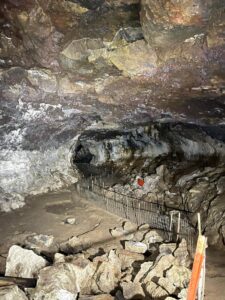BY HARRY WEEKES

I had planned on taking the obvious road this time—writing about the wildflowers and what has been nothing short of their ridiculous profusion. Arrowleaf balsamroot, lupine, phlox, flax, delphinium, daisies, little yellow ones, ground-dwelling pink ones, bog-blossoming purple ones, and the six to seven gazillion insects that have been on nothing short of a 100-year nectar binge.
And then, another path emerged. There I was, just north of Shoshone, shuttling one of our buses to Jerome for servicing, and the four white letters surrounded by blue popped out on the side of the road: “C A V E”
You know the sign.
There is another, more official brown one that says something about the Mammoth Cave. As if ‘cave’ alone wasn’t wonderful—this is a MAMMOTH cave!
Of course, I was instantly wondering, is this a really big cave or an actual cave where Mammoths lived? (I wasn’t actually wondering either of those things because I have spent some time at this cave. One of the great aspects of growing up a child of my mother, we have been to the caves and lava tubes and accompanying menagerie of taxidermied creatures in the museum to which this sign points.)
I recently finished a book titled, “How to Write Short,” which was, you guessed it, about writing short—keeping things brief, sweet, and to the point. One exercise the author suggested was looking for examples of great short writing (candy wrappers, flyers, bumper stickers, etc.). This sign instantly became my favorite.
Cave. How evocative is that? One word. So many possibilities.
The constellation of thoughts that went through my mind from this simple, giant word went like this: The abovementioned wondering if this was a giant cave or a cave with giant fuzzy elephants. Batman. A visceral remembrance of standing, quasi-hunkered in a bat hibernaculum in Vermont with my Field Studies class amidst the whirr of several thousand bats moving to and fro as our excited professor gently showed us the anatomy of these furry fliers. An irrelevantly sunny afternoon in college when a beast of a man named Keck showed up with his buddy called Squirrel and took me spelunking, which is to say we wedged ourselves into the earth on the edge of some farmer’s field, and I spent the next three hours really hoping not to die.
Cave.
Is there anyone who reads, sees, or hears this word and has no association with it? Maybe it’s through literature and Jean M. Auel’s “The Clan of the Cave Bear.”Or the great cenotes of Mexico and Central America—those impressive limestone sinkholes that are their own ecosystems. Or maybe it’s all mines and cat holes scratched into and through the hills of the valley. Perhaps you think of cool, damp spaces, or maybe it’s warm dry ones that protect you from the elements.
To me, a cave is a special kind of hole with a story. It’s where things live, or hide, or cache. It’s a portal to a hidden world, a magical space creatable with couch cushions in your living room, and a mysterious entrance to the unknown on the other end of a strange sign and a white arrow off of Highway 75.
When I try to condense nature into powerful words—storm, forest, ocean—each carries with it an ability to transport me into another world. Into the world. And cave? Perhaps surprisingly, this word carries me, ultimately, to a safe space. Cave. I am content there.
To think it can do all of this at 65 mph in a mini-bus.
Cave. What a word.


